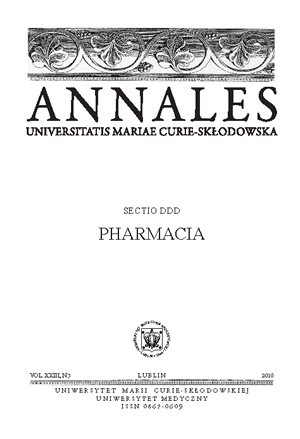Chemical composition and antioxidant activity of the essentials oil of hyssop (Hyssopus officinalis L. ssp. officinalis)
Keywords:
Hyssopus officinalis L., hyssop, essential oil, cis-pinocamphone, GC/MS, GC/FIDAbstract
The plants of Hyssopus officinalis L. were grown in the herb garden at the Faculty of Pharmacy, Medical University of Lublin, Poland. The oil obtained with the use of steam distillation from the air-dried, aerial parts of hyssop was analysed by the means of GC/MS and GC/FID techniques. Sixty-nine components were found, representing 99.7% of the essential oil and sixty-three of them were identified. The major constituents were identified as cis-pinocamphone (48.6%), elemol (7.4%), β-pinene (6.1%), 1,8-cineole (5.8%) and caryophyllene oxide (5.2%).
References
1. Adams R.P.: Identification of essential oil compounds by gas chromatography/quadrupole Mass Spectroscopy. Allured Publishing Corporation, Carol Stream, Ill, USA 2004.
2. Benito M., Jorro G. et al.: Labiatae allergy: systemic reactions due to ingestion of oregano and thyme. Ann. Allergy Asthma Immunol., 76, 416, 1996.
3. Burfield T.: Safety of essential oils. Int. J. Aromather., 10, 16, 2000.
4. Fraternale D., Ricci D. et al: Composition and antifungal activity of two essential oils of Hyssop (Hyssopus officinalis L.). J. Essent. Oil Res., 16, 617, 2004,
5. Garg S.N., Naqvi A.A., Singh A. et al.: Composition of essential oil from an annual crop of Hyssopus officinalis grown in Indian plains. Flav. Fragr. J., 14, 170, 1999.
6. Góra J., Lis A.: Najcenniejsze olejki eteryczne. Ed. UMK, Toruń 2004.
7. Gorunovic M.S., Chabard J.L. et al.: Essential oil of Hyssopus officinalis of Montenegro origin. J. Essent. Oil Res., 7, 39, 1995
8. Hoppe H.A.: Drogenkunde I. Valter de Gruyter Verl Eds. Berlin-New York 1975.
9. Joulain D., König W.A.: The atlas of spectral data of sesquiterpene hydrocarbons. E. B. – Verlag, Hamburg 1998.
10. Lu M., Battinelli L., Daniele C. et al.: Muscle relaxing activity of Hyssopus officinalis essential oil on isolated intestinal preparations. Planta Med., 68, 213, 2002
11. Mazzanti G., Battinelli L., Salvatore G.: Antibacterial properties of the linalol-rich essentials oil of Hyssopus officinalis L. var. decumbens (Lamiaceae). Flavour Fragr. J., 13, 289, 1998.
12. Mitić V., Derdević S.: Essential oils composition of Hyssopus officinalis L. cultivated in. Serbia. Facta Univer., 2, 105, 2000.
13. NIST/EPA/NIH: Mass Spectral Library, USA, 2002.
14. Ozer H., Sahin F. et al.: Essential oil composition of Hyssopus officinalis L. subsp. angustifolius (Bieb.) Arcangeli from Turkey. Flavour Fragr. J., 20, 42, 2005.
15. Polish Pharmacopoeia Vol. VI, PTFarm. Warsaw 2002.
16. Renzini G, Scazzocchio F, Lu M. et al: Antibacterial and cytotoxic activity of Hyssopus officinalis L. oils. J. Essent. Oil Res., 11, 649, 1999.
17. Salvatore G., Nicoletti M., D’Andrea A.: Essential oil composition of Hyssopus officinalis L. J. Essent. Oil. Res., 10, 563, 1998.
18. Tisserand R.: Essential oil safety II. Int. J. Aromatherapy., 7, 26, 1996.
19. Tognolini M., Barocelli E., Ballabeni V. et al.: Comparative screening of plant essential oils: Phenylpropanoid moiety as basic core for antiplatelet activity. Life Sci., 78, 1419, 2006.
20. Vallejo G.M.C., Herraiz J.G. et al: Analysis by gas chromatography–mass spectrometry of the volatile components of Hyssopus officinalis. Essent. Oil Res., 7, 567, 1995.
21. Vincenzi M., Silano M. et al.: Constituents of aromatic plants: I. Methyleugenol. Fitoterapia, 71, 216, 2000.
22. Wolski T., Baj T., Kwiatkowski S.: Hysop (Hyssopus officinalis L.) forgotten medicinal, flavoring and honey-yields plant. Annales UMCS, Sect. DD, 61, 1, 2006.
23. Wolski T., Baj T.: Hyzop lekarski (Hyssopus officinalis L.) – aromatyczna roślina lecznicza. Aromaterapia., 12, 10, 2006.
Downloads
Published
Issue
Section
License
Copyright (c) 2010 Authors

This work is licensed under a Creative Commons Attribution-NonCommercial-NoDerivatives 3.0 Unported License.


